NOTE: This story was written in the summer of 2008. Look for an updated version of “Greening” later this year…JS
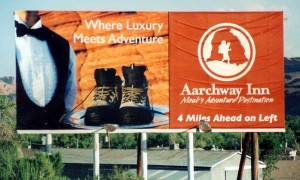 ..this is what is wrong with the conservation movement. It has a clear conscience….To the conservation movement, it is only production that causes environmental degradation; the consumption that supports the production is rarely acknowledged to be at fault. The ideal of the run-of-the-mill conservationist is to impose restraints upon production without limiting consumption or burdening the consciences of consumers.
..this is what is wrong with the conservation movement. It has a clear conscience….To the conservation movement, it is only production that causes environmental degradation; the consumption that supports the production is rarely acknowledged to be at fault. The ideal of the run-of-the-mill conservationist is to impose restraints upon production without limiting consumption or burdening the consciences of consumers.
Wendell Berry
Nobody hates the conservation movement more than Rush Limbaugh. His daily diatribes against “environmentalist whackos” mock every aspect of it—from the protection of endangered species to the application of alternative energy sources to the severity of global warming—or even its existence—it’s all one big bad joke to the right-wing polemicist.
Among his most frequent targets is the conservation hierarchy. He entertains his legions of listeners daily as he mocks and ridicules venerable institutions like the Sierra Club, Greenpeace and the Wilderness Society— the mainstream environmental community. According to Limbaugh, these are the people who embrace environmentalism as a secular religion of sorts. They believe, he says, “that God is the earth and that God is nothing more than the earth. Actually, it is a modern form of pantheism, where nature is divine. This group,” Limbaugh declares, “wants to preserve the earth at all costs. They want to roll us back, maybe not to the Stone Age, but at least to the horse-and-buggy era.”
 That’s Limbaugh’s take on environmentalists in America today; after all, the King of Right Wing Talk Radio does have a way of painting very broad strokes when he imposes his “vision” on a plethora of issues. But while there may indeed be members of these organizations who long for horseless carriages and oil lamps, when it comes to the money and power that supports those groups, nothing could be farther from the truth.
That’s Limbaugh’s take on environmentalists in America today; after all, the King of Right Wing Talk Radio does have a way of painting very broad strokes when he imposes his “vision” on a plethora of issues. But while there may indeed be members of these organizations who long for horseless carriages and oil lamps, when it comes to the money and power that supports those groups, nothing could be farther from the truth.
In fact, when Limbaugh says, “Capitalism is good for people AND for other living things,” he’d find more than a few enthusiastic nods from some of the most powerful environmentalists in America today. Being “green” has multiple connotations.
From its origins, the conservation movement, by its very name, has always evoked images of and aspirations to a simpler, less materialistic life. And it made sense—if we loved Nature, if we hoped to preserve and protect what remained of wild and free country, then we had to look to our own behavior first. And our own lifestyles. There has always been a clear link between our relentless consumption of natural resources and the degradation of the land, water and air we cherish.
More than a century and a half ago, Henry David Thoreau set a standard for environmentalists and the life we need to pursue when he wrote, “Most of the luxuries, and many of the so-called comforts, of life are not only not indispensable, but positive hindrances to the elevation of mankind.” He warned, “”Our life is frittered away by detail…simplify, simplify…”
And most fitting and meaningful of all, “A man is rich in proportion to the number of things he can afford to leave alone.”
Indeed. Consider David Bonderman.
DAVID BONDERMAN, ‘THE DEALMAKER’ & ‘HIS EVER MOVING VORTEX’ FORTUNE
magazine calls him one of the “Kings of American business. They are the architects and managers of private equity firms and hedge funds, amassing untold billions of dollars. And, among this extremely quiet species,” FORTUNE declares, ” David Bonderman is as dominant as they come. He has earned a reputation as a master dealmaker, a tornado of a man spinning equal parts brilliance, energy, and charm inside his ever-moving vortex.”
David Bonderman is a venture capitalist. His private equity firm, Texas Pacific Group (TPG), buys failing or marginal or undervalued corporations, “streamlines” the operation, sometimes breaks the company into pieces and makes huge profits. In 2005 TPG claimed to have $20 billion under management, “a gaudy sum,” says FORTUNE, ” that includes a series of under-the-radar Texas Pacific affiliates in the U.S. and Asia.” The number has since risen.
He has served on the Boards of many public companies, including Burger King Holdings, Inc.; CoStar Group, Inc.; Gemalto N.V.; and Ryanair Holdings, plc, of which he is Chairman. Recently TPG bought a controlling interest in TXU, the largest utility company in Texas.
FORTUNE observes: “Bonderman’s high-profile deals have given him a mystique. He’s the man who can close the sale, and his secretive style only feeds his aura. People  may not see how he does it, but they see the results. The stealth isn’t just a matter of personal preference. Bonderman has learned it’s much easier to conduct business far from the prying eyes of the media, stock analysts, and the public.
may not see how he does it, but they see the results. The stealth isn’t just a matter of personal preference. Bonderman has learned it’s much easier to conduct business far from the prying eyes of the media, stock analysts, and the public.
” His estimated worth is $3.3 billion, good enough to be ranked the 105th richest American in 2007. He owns a 15,000 square foot mansion in Aspen, Colorado and a sister home, also 15,000 square feet, is under construction adjacent to the Scott Matheson Nature Preserve in Moab, Utah. But as FORTUNE points out, “he jets around the world in a Gulfstream GV. (Actually, his ‘official residence’ is in Fort Worth and his family stays in Aspen, but he might as well list his address as the GV.)…Rare is the week he doesn’t go abroad. At the same time, he’s calling and e-mailing incessantly. People who work with him say it’s routine to get calls back within a few hours whether Bonderman is in San Francisco, Dublin, Seoul, or anywhere in between.”
When Bonderman turned 60, he threw a party for himself in Las Vegas. He rented out the Hard Rock Café for the entertainment part of the evening, then took his guests back to the Bellagio for food and partying. Robin Williams and John Mellencamp opened the show, but Bonderman wanted a bigger act, so he hired the Rolling Stones for a cool $7 million. Vegas papers reported that the entire evening’s festivities surpassed $10 million.
Bonderman must have enjoyed his Vegas experience— in 2007, TPG bought Harrah’s Entertainment, Inc.(now re-named Caesar’s Entertainment, Inc.), one of the largest leveraged buyouts in history. The acquisition of more than 40 casinos across the country includes the MGM Grand, Bally’s, Caesar’s Palace, Harrah’s, The Flamingo, Paris Las Vegas, Rio All Suite Hotel and Casino, and Bill’s Gamblin’ Hall & Saloon–all in Las Vegas. And add a couple of Vegas golf courses.
And, according to Sports Business Daily, Bonderman even plans to join “MGM Studios Inc. Chair and CEO Harry Evans Sloan and producer Jerry Bruckheimer as equal partners” to secure an NHL team for Las Vegas.
Despite his enormous wealth and extravagant lifestyle, however, Bonderman is highly regarded by the mainstream environmental community in the United States. He serves on the boards of the Grand Canyon Trust, the Wilderness Society and the World Wildlife Fund. His charitable contributions to these and many other groups measure in the millions. For that, Charles Wilkinson, the president of the Grand Canyon Trust, has hailed Bonderman as “one of the country’s greatest conservationists right now.”
THE CONSERVATION MOVEMENT & THE NEED FOR ‘GREEN’
Bonderman is just one of many from the realm of the mega-rich who have recently embraced environmentalism as their cause celebre. Mega-millionaires, even billionaires fill the boards of directors of almost every major mainstream environmental organization in America. In fact, the money that pours into the coffers of these groups has made it a multi-billion dollar industry. Consider some of the assets and payrolls of the nation’s most popular national groups.
The Wilderness Society has net assets of almost $35 million. Its top staffers receive annual salaries between $140,000 and $175,000. And among its “key employees,” president William H. Meadows received an annual salary of $252,000, plus a $14,000 expense account.

Some of its greatest expenses go to telemarketing ($300,941), a mailing list broker ($244,168) and direct printing/mailing ($646,823). Of its assets almost $20 million is invested in “money market funds, equities and corporate bonds.” It even makes $142,000 a year in royalties by putting its name on credit cards.
At The Nature Conservancy, net assets approach $4 billion, Managing those assets comes at a high price as well. TNC’s “managing director of human resources,” Darryl Varnado received $385,000 in salary and benefits in 2005. Four other top staffers earned between $225,000 and $250,000 annually.
Accounting and tax services exceeded $1.5 million and Cornerstone Partners LLC, Investment Consultants were paid $1.6 million for their services.
Still, TNC’s net assets grew by another $350 million in 2005.
And the National Resources Defense Council (NRDC) claims assets exceeding $73 million. Its president earns $360,000 is salary and benefits, its executive director, about $240,000. But despite these high salaries and the positioning of very wealthy individuals on the boards of directors—it is after all the boards that set policy and goals, not the lifetime staffers that carry most of the day to day workload—is it really a problem?
Environmentalists face extraordinary and persistent opposition from well-funded lobbyists and corporations who have unlimited amounts of money. The argument made, over and over again by the green community is that it must have the financial resources to fight the “bad guys,” and that the generous contributions of the mega-wealthy are an indispensable aspect of that strategy.
Chris Peterson, a former executive director of the Glen Canyon Institute, now with the Murie Center in Wyoming noted in 2004, “Those with experience in the field of environmental advocacy deem it necessary to play ‘dirty’ and enlist any and all means necessary to accomplish their goals, believe that walking the alternative ‘high road’ is an exercise in futility and ultimately leads to failure. (sic)”
It is true that philanthropy by the very wealthy has greatly enriched and improved American Life. Colleges and universities, museums, art galleries, libraries, medical research—all of these institutions have flourished in part at least to the generosity of a limited few. Humanitarian aid by the wealthy to provide food and shelter and medical assistance to disaster victims around the world is universally praised.
But when it comes to social and political issues, where opinions vary and philosophies clash, the line between charitable giving and undue influence becomes a blur. Can a social activist accept money from an individual or company, whose goals and values stand in direct contradiction to those of the recipient? For example, years ago, Harvard University was forced to divest itself of stock investments with Exxon Oil because the company operated in South Africa and many critics believed the company contributed to apartheid there. Harvard eventually sold its stock to avoid any suggestion of impropriety or charges of hypocrisy. It is a frequent dilemma.
Should environmentalists have the same concerns? And do these wealthy benefactors offer their financial resources out of genuine fears for the planet’s well-being and a desire to improve the quality of our environment, or is it simply one more public relations enhancement for their global corporate portfolios? Or even worse, is it a way of controlling and diverting policy decisions that might well impact their own financial interests?
As Harold Shepherd, the Issues Director of the Moab, Utah based Redrock Forests has noted, “…perhaps in the 21st Century, idealism is no longer applicable.”
Again, as an example, David Bonderman’s international business interests offer some paradoxes worth noting—so much so that his extravagant personal life, by comparison, hardly elevates, relatively speaking, a concerned eyebrow.
TPG/TXU
THE OLD ‘BAIT AND SWITCH?’
 Among Texas Pacific Group’s most recent acquisitions, none has received more fanfare than its purchase last year of TXU, the giant Texas utility company. Partnered with the investment firm Kohlberg Kravis, their bid of $45 billion made it the biggest buyout in history.
Among Texas Pacific Group’s most recent acquisitions, none has received more fanfare than its purchase last year of TXU, the giant Texas utility company. Partnered with the investment firm Kohlberg Kravis, their bid of $45 billion made it the biggest buyout in history.
Working with The National Resources Defense Council (NRDC) and the Environmental Defense Fund (EDF), TPG promised to transform the utility company into one of the greenest in the nation. Their commitment included a reduction in the number of coal-fired power plants that TXU had proposed to build in the next decade, from eleven to just three.
Many conservationists were ecstatic. Treehugger.com reported that it, “hopes the good guys have enough personal energy and carbon offsetting credits at hand to saddle up for a ride to the next town that needs their help. The climate bad guys have had ‘free reign’ for a long time.” As for the #1 “good guy” behind the move, they reported that, “David Bonderman bleeds green. But those who know the man behind the largest buyout in history say it’s as much from being Earth-friendly as money hungry.”
But Andrew Ross Sorkin, the respected reporter for the New York Times, had a more realistic view of the buyout. In a February 2007 story called, “Many Shades of Green,” Sorkin noted that it was the collapse of TXU stock, driven down by worried investors who feared what eleven new power plants would do to the financial stability of the company, that caught TPG’s eye in the first place. Private equity firms are always on the lookout for undervalued companies and this was one of them.
Even TXU saw the financial risks associated with such an aggressive building program and, according to Sorkin, had already planned to scrap six of the proposed coal-fired generating stations. TPG, the NRDC and EDF claimed victory and both environmental groups called the acquisition a landmark moment for corporate/environmental cooperation. But the bottom line was still the bottom line—for the new owners of TXU, the revenues from the utility that would have gone to the construction of the power plants would now be used to pay off the cost of the acquisition. It was a very good deal for TPG and David Bonderman.
Then, two months later, while NRDC and EDF basked in the glow of their TXU victory, Bonderman and his newly acquired utility upset the cart with another stunning announcement. While TXU would scrap all but three of its proposed coal-fired power plants, it would also move forward with the design and construction of the largest nuclear power plants in the United States.
As recently as last year, EDF noted in its online newsletter, “Serious questions of safety, security, waste and proliferation surround the issue of nuclear power. Until these questions are resolved satisfactorily, Environmental Defense cannot support an expansion of nuclear generating capacity. We need a rigorous federal research program to address these questions, so that our nation will have the information needed to make sound decisions in the future. The problem of global warming is so serious that we must thoroughly consider every low-carbon option for generating power.”
Both groups were shocked by the announcement. On a 2007 “Living on Earth” program on National Public Radio, the sudden switch was discussed by representatives from both organizations. According to a transcript, ” NRDC attorney Geoff Fettus says dozens of issues were discussed with one notable exception.”
According to Fettus, “As far as I understand it the nuclear issue did not come up.”
But Jim Marston, the climate initiatives director for EDF in Texas seemed resigned to the change. “We have come to the conclusion that the threat of global warming is so severe and the time for action is so short,” Marston reasoned, “that we have to look at all low carbon options again including nuclear.”
And in 2008, the NRDC’s Thomas Chochran appeared before the House Science and Technology Committee. The NRDC couldn’t even muster the courage to give a clear environmental thumbs-down to the expansion of nuclear power. Instead their testimony centered on assessing the feasibility of nuclear power from the investor’s point of view.
Chochran noted, “it’s not whether you are for or against nuclear power per se…if nuclear power can compete on a level playing field [without subsidizing new construction] let it compete.” And he insisted that, “capping carbon would provide the single greatest benefit to the nuclear industry today” are those of utterly compromised environmentalism.
NRDC concluded, “…Nuclear has made a contribution to climate change mitigation and will continue to make a contribution… In the case of the NRDC, rubbing shoulders with some of the world’s biggest capitalists, who happen to have major nuclear power ambitions themselves, has apparently influenced their language.
The nuclear option that just weeks earlier needed “rigorous federal research” will be played sooner than later. Bonderman’s power, with a single stroke, has, at the very least, confused the nuclear energy policies of two of the largest environmental groups in the United States.
The news could only have pleased one gentleman, who a few years ago had this to say about environmentalists’ opposition to nuclear power: “If we had nuclear power, we would not be as concerned about ‘our dependence on foreign oil.’ We wouldn’t be as concerned about the pollution of coal. But we can’t have nuclear power, because it threatens the environment. We can’t have nuclear power because they say it might hurt people…”
That man is Rush Limbaugh. NRDC, EDF and David Bonderman are his newfound allies. Even if they refuse to admit it.
RYANAIR AND “THE IRRESPONSIBLE FACE OF CAPITALISM”
Still Bonderman’s star shines brightly among most conservationists in this country. But on the other side of the Atlantic, the story is quite different. David Bonderman is chairman of the board of directors of Ryanair, a discount airline in Great Britain that has recently come under attack from Green groups and even the Environment Minister of the British government.
His handpicked CEO, Michael O’Leary, has worked furiously to make Ryanair the largest discount airline in Europe. In 2005, when he and Bonderman moved forward with plans to buy 70 new Boeing 737-800 aircraft, O’Leary noted Bonderman’s presence at the meeting, “He’s a lot richer than me and we need the guy with the big cheque book to show up for the big ticket items,” according to the UK’s Daily Telegraph.
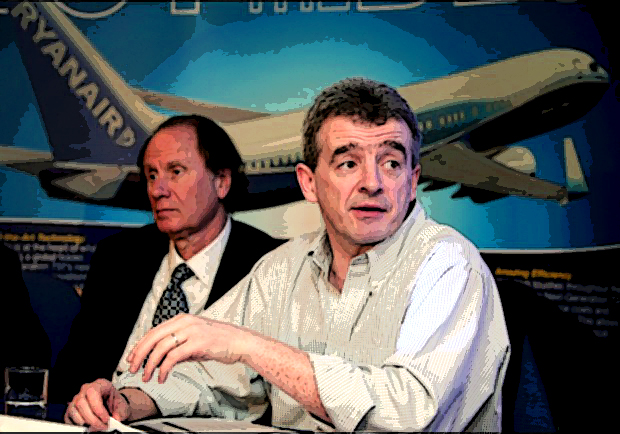
He has also steadfastly and loudly opposed efforts to place environmental restrictions on the airline industry.
According to the UK newspaper, The Guardian, “Mr O’Leary said: ‘Most of this environmental hysteria is an excuse for the government to raise tax revenues. People are being scammed here.’ …Mr O’Leary reiterated his opposition to the EU carbon emissions trading scheme, which airlines are due to join in 2011 and which would require carriers pay for the carbon they emit, adding up to ££25 to the cost of a long-haul ticket.”
Ian Pearson, the UK Environment Minister responded: “Like every other industry, the airline industry must take its share of responsibility for combating climate change and the European Union’s proposal is the vehicle by which they can do just that.”
And he had these words for Mr. O’Leary and his airline: “When it comes to climate change, Ryanair are not just the unacceptable face of capitalism, they are the irresponsible face of capitalism. O’Leary just seems to take pride in refusing to recognize that climate change is a genuine problem.”
O’Leary shot back, calling the Environment Minister, “foolish and ill-informed.” He insisted that “Ryanair has spent more than $10 billion on a fleet of fuel-efficient engines which have reduced fuel burn by 45% and cut CO2 emissions by 50% per passenger, making Ryanair Europe’s greenest airline.”
But Ciaráán Cuffe, the Green Party Environment spokesman was not buying any of O’Leary’s claims.. In a January 2007 press release, he had this to say:
“Michael O’Leary accuses politicians and environmentalists of telling lies, but he is the biggest liar of all. Ryanair is one of the most ardently anti-Green airlines in Europe, and is vehemently opposed to entering into an EU emissions trading system that would see it have to account for its sky-rocketing pollution. If anybody is talking nonsense about the environment, it is Michael O’Leary, not the UK’s Environment Minister Ian Pearson who said Ryanair was not taking the issue of greenhouse gas emissions seriously.
“Ryanair’s rabid boss is trying to use the same old tricks with the environment as he does with so many other issues; arrogance, bluster, diversion and misinformation. But this time it just won’t wash. His lies about airline emissions being reduced as a result of new planes is utter baloney. Claims that new aircrafts have reduced CO2 emissions by 45% over the past eight years are almost entirely worthless when contrasted with an increase in passenger numbers of over 600% in the same period. Rather than decreasing, in net terms Ryanair’s greenhouse gas emissions have gone through the roof. Michael O’Leary is the fool if he expects anybody to believe that he has a Green bone in his body.”
But perhaps the most reasoned assessment of Ryanair’s complicity, or lack of it, came from a web site called, lowcarbonlife.net.
(January 10th 2007) Rather than write-off Michael O’Leary as a self-serving apologist for Ryanair, environmentalists need to engage with what he says. His main points are
– aviation is responsible for less than 2% of global emissions
– Ryanair runs an extremely fuel efficient fleet
The first point is entirely correct. However, he refers to global levels of CO2 emissions. In the UK, the figure is nearer 6%. Mr O’Leary also ignores the impact of greenhouse gases other than CO2. The science is not yet entirely robust, but it looks like we should multiply the CO2 emissions from air travel by about 3 to capture the full global warming effect of aviation. This means that about 18% of the UK’s emissions are produced by aviation. (This excludes the fuel consumption necessary to support the aviation industry, including the transport to airports and the substantial cost of actually running the ground operations).
More important, the emissions from aviation are probably growing at about 4-5% a year in the UK. (Because aviation is not covered in Kyoto, statistics are little uncertain). For the UK, therefore, aviation is the single greatest source of increases in emissions. If are to stop the continuing rise in greenhouse gas volumes, we have to act on aviation. We need to do other things as well, but aviation must be a target.
What about the ‘new, fuel-efficient’ aircraft point? The problem with Mr O’Leary’s argument is that when he buys a brand-new Airbus and trades in his old model, the older airplane still remains in the sky, and will probably still be carrying passengers in 2025. And he exaggerates the fuel efficiency gains from new planes. Today’s models are getting 1% or so better fuel economy every year. This is nowhere near enough to compensate for the growth in travel.
With the cold hard facts, lowcarbonlife.net managed to call into question most of O’Leary’s arguments.
Bonderman, as chairman of the board and director of Ryanair Holdings, keeps a low profile, lets O’Leary do the talking and allows him take the heat. And in 2008, while other airlines struggle to stay alive, Ryanair managed to break even for the first half of the year. Clearly, O’Leary may not be a friend to the planet, but he has Bonderman’s unequivocal support…as long as the bottom line pleases him.
And so, Ryanair continues to maintain that calls for carbon taxes are “scams” and that much of the global warming fears are nothing but “environmental hysteria.” In so doing, Mr. O’Leary sets a tone far different than the one Bonderman plays in the U.S.
THE GREENING OF THE GRA$$ ROOT$
While Bonderman dashes about the planet cutting deals and making money, his flamboyance may be more noteworthy than others, but he is by no means the only mega-rich contributor to this country’s mainstream environmental movement.
Consider The Wilderness Society (TWS), one of the largest and most influential green groups in the U.S. Bonderman sits on TWS’s governing council with six other members: Brenda Davis is a vice president with Johnson & Johnson. Caroline Getty is an heir to the Getty fortune. At $400 million, she is the 301st wealthiest American on the Forbes list. Scott Nathan is the managing director of the Baupost Group, a Boston-based investment firm with a $4 billion portfolio. Doug Walker is the board chairman of Recreational Equipment, Inc (REI), one of the largest outdoor equipment and clothing companies in the United States, and Hansjorg Wyss is the 72nd richest person on the planet; his estimated worth is $8.7 billion.
Only board member Marcia Kunstel, a former journalist and owner of a luxury dude ranch in Jackson Hole, Wyoming seems less than seriously rich. But she must prefer the company she keeps on TWS board—a three night visit (that’s the minimum booking allowed) at her Flat Creek Ranch costs a family of four almost $3000. How could anyone less than a Wilderness Society board member afford to stay there?
But what about the smaller, regional and local environmental organizations across the country? Those groups that operate at the grassroots? For years the grassroots greens almost took a certain pride in their poverty. It was their dedication and zeal that mattered, not their mutual funds.
A few years ago, The Wilderness Society honored a man they called “the stuff of legend.” His name is Brant Calkin, a dedicated environmentalist for almost half a century. Noting his accomplishments, TWS’s president William H. Meadows called Calkin “fearless and outspoken.” Citing his accomplishments, Meadows noted his work at the Grand Canyon and in the redwood forests of northern California. “But I believe his greatest achievement was in Utah,” observed Meadows. “He took a little outfit named the Southern Utah Wilderness Alliance and turned it into a powerhouse that is a model of an effective state conservation group.”
But he didn’t do it with money. If anything Calkin loathed the connection between big money and good environmental work. His protege and longtime admirer, Scott Groene, wrote in praise of his boss, in this publication, in 2000:
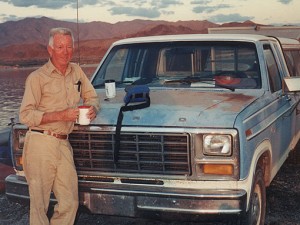 “Brant Calkin is the best damn environmentalist that ever worked on the Colorado Plateau, and he’s done more to protect southern Utah wilderness than anyone alive or dead. He created the strategy for saving the canyon country that’s been followed successfully for the past decade, set the tone for the wilderness debate, was mentor to a slew of activists, and built the Southern Utah Wilderness Alliance. And he did it with a quiet humility, integrity, and basic decency towards both his opponents and friends.”
“Brant Calkin is the best damn environmentalist that ever worked on the Colorado Plateau, and he’s done more to protect southern Utah wilderness than anyone alive or dead. He created the strategy for saving the canyon country that’s been followed successfully for the past decade, set the tone for the wilderness debate, was mentor to a slew of activists, and built the Southern Utah Wilderness Alliance. And he did it with a quiet humility, integrity, and basic decency towards both his opponents and friends.”
But, according to Groene, Brant Calkin was adamant about money, or the need to avoid an obsession with it at all costs. Groene wrote:
“Brant offered his staff low pay but lots of autonomy to ‘do good and fight evil. The benefit of lousy pay is you get to experiment.’ Calkin offered low wages because no environmentalist should be in it for the money, and ‘pay doesn’t affect the quality of the staff.’ He offered as rationale both that environmentalists have an obligation to spend their members’ money wisely, and that small salaries ensure that only the passionate keep their jobs…while experience is useful, it doesn’t automatically result in better or smarter actions: ‘smart young people with fresh ideas are just as important as those who have been around the track a couple of times.’
“Brant never asked his staff do anything he wasn’t already doing….he and Susan Tixier earned a total annual salary of $20,000 between the two of them as Director and Associate Director… Brant never stopped working, whether it was leading the Utah Wilderness Coalition out of shaky consensus efforts, hustling money, or fixing a fleet of beater SUWA cars (he was renown for resurrecting aging office equipment and trucks). And when it seemed everything was done, he’d start cleaning the office.”
Groene noted that the combined salaries of Calkin and Tixier were about a third of what the Executive Director was being paid in 2000. Now it’s closer to a quarter.
In the late 1990s, SUWA found itself the beneficiary of more wealth than it might have ever dreamed possible when Hansjorg Wyss, the billionaire on TWS board joined theirs as well. He has served as SUWA’s chairman for a decade. Not only did Wyss contribute directly to SUWA’s operating funds, he bought them a new office, an old three story home in downtown Salt Lake City, for about $900,000 and gave another $500,000 to renovate and furnish it. Also joining the board was mega-millionaire Bert Fingerhut.
Fingerhut also served on the board of the Grand Canyon Trust (GCT). So does Wyss. Wyss is on the Governing Council of TWS. So was Fingerhut. So is David Bonderman.  Bonderman sits on the GCT board. So does Wyss. So did Fingerhut. If any citizen tries to cross-reference the participation of some of the mega-rich on these boards, the results are startling. It gets to be a bit incestuous. (NOTE: Fingerhut resigned all of his board member positions in early 2007 when he pleaded guilty to securities fraud. He is now serving a two year sentence in a federal correctional facility.)
Bonderman sits on the GCT board. So does Wyss. So did Fingerhut. If any citizen tries to cross-reference the participation of some of the mega-rich on these boards, the results are startling. It gets to be a bit incestuous. (NOTE: Fingerhut resigned all of his board member positions in early 2007 when he pleaded guilty to securities fraud. He is now serving a two year sentence in a federal correctional facility.)
The same kind of wealth that came to SUWA has made its way to the Flagstaff-based Grand Canyon Trust—it is small, relative to such green powerhouses as TWS and NRDC, but its board of trustees, for pure money power, could go toe to toe with the Big Boys anytime. In addition to Wyss and Bonderman, GCT’s board includes (and the descriptions come from GCT’s web site):
Lou Callister: “chairman of the law firm of Callister, Nebeker & McCullough in Salt Lake City and is listed in “The Best Lawyers in America” in Banking Law . He is the immediate past president of and on the Board of Trustees of the Economic Development Corporation of Utah.”
Pam Hait: “a principal with STRATEGIES, a marketing firm specializing in tourism development and community relations.”
Carter Bales: “co-founder and general partner of The Wicks Group of Companies, L.L.C., a private equity firm that makes control investments in the communications, information and media industries.”
Bill Budinger: “founder, chairman, and CEO of Rodel, Inc. Rodel is a manufacturer of products used by the semiconductor industry, with offices all over the world.”
Oscar (Bud) Marx: “CEO of TMW Enterprises, a private equity partnership with diversified investments in electronics, plastics, metal-forming, technology, and real estate.”
Garry Snook: “Chairman/CEO of Performance Inc…The company has grown to be the largest specialty retailer of bicycle product, plus the largest direct merchant of cycling products through their three unique catalogue and internet companies.”
Here are some more Colorado Plateau green group numbers and bits of trivia to ponder:
* GCT’s net assets approached $7.5 million in 2006, up a million from the year before. It had an employee payroll in 2006 that exceeded $1 million and its executive director made $132,000 in salary, benefits and expense accounts. SUWA’s net assets passed $6 million in 2006, with a $700,000 payroll.
* Among its recent donors, GCT received $1 million from the founders of INTEL, $389,000 from Bonderman, $200,000 from Wyss, $75,000 from the Rodel Foundation (board member Bill Budinger) and scores of donations in the $20,000 to $50,000 range, from a host of foundations and trusts.
* According to a former staffer, three of GCT’s trustees fly to board meetings on Gulfstream jets. One of them insists on being reimbursed by GCT for the $18,000 in jet fuel that his Gulfsteam burns for each trip. Then he writes a check for that amount back to the Trust; this way he can write it off as a charitable deduction.
* At SUWA, a former board member recalled Hansjorg Wyss’s penchant for spur of the moment backpack trips to some remote corner of the Colorado Plateau. He’d invite  staff members along and they’d fly south on his Gulfstream to some remote airstrip for a weekend jaunt into the canyons. Who could resist? Much less complain… (A single cross-country round trip on a Gulfstream IV, or GIV, churns out about 83,000 to 90,000 pounds of carbon dioxide. Per capita, the average American produces 50,000 pounds from all activities in an entire year.)
staff members along and they’d fly south on his Gulfstream to some remote airstrip for a weekend jaunt into the canyons. Who could resist? Much less complain… (A single cross-country round trip on a Gulfstream IV, or GIV, churns out about 83,000 to 90,000 pounds of carbon dioxide. Per capita, the average American produces 50,000 pounds from all activities in an entire year.)
* SUWA benefactor Amin Khoury made a $50,000 contribution in 2006. According to the Palm Beach Post, “The biggest compensation package (for Palm Beach, FL) in 2006 belonged to Amin Khoury, 68, chairman and chief executive of Wellington-based BE Aerospace. He made $15.2 million, thanks in large part to $9.6 million in gains on stock options. Khoury also collected a salary of $904,000 and nearly $2.2 million in retirement contributions.” Khoury has made a fortune creating more comfortable airline seats. Whether Bonderman and Wyss use his creation on their GVs is unknown.
THE RISK of HYPOCRISY…THE COST of BEING COMPROMISED
All this would be nothing more than a wealth of fascinating information about the wealthy if it were not for the troubling implications that come with it. We once argued President Clinton was a moral man with some questionable obsessions, but that his lack of fidelity to his own wife had nothing to do with his honesty and dedication to his country.
Some might argue now that the opulent wealth and personal habits of this group of green benefactors has nothing to do with the goals and dreams of the conservation movement. Or that their generous contributions could ever be thought of as tainted or hypocritical. As a leading Moab conservationist declared recently, “Money has no conscience.”
But surely the people that possess that money must have a conscience. How could it be otherwise?
And more significant, and damaging to the reputations of environmental groups is the risk that these powerful and wealthy board members are in fact altering environmental policies and even firmly held ethical beliefs by its leaders and members to suit their own agendas.
David Bonderman’s ability to help alter the nuclear energy policies of two of the most powerful environmental groups in the United States, almost overnight, has already been offered as a dramatic case in point. Do any of the following examples create a similar element of doubt?
* In 1994, the Salt Lake Tribune reported on the growing number of backcountry/wilderness guidebooks being sold and the way different Utah environmental groups were dealing with them. “Within conservation groups,” the Tribune reported, “where-to-go journalism has become a contentious issue. While organizations like the Sierra Club sell trail guides, the Southern Utah Wilderness Alliance will not endorse any guidebook. The decision apparently came after a SUWA official allowed his accolades to be printed on the back of a guidebook. The book revealed details of several little-known hiking destinations in Utah’s San Rafael Swell.”
According to the story, then-SUWA staff attorney Scott Groene explained, “We have not actually come out yet and started burning guidebooks, but given our goals of trying to protect the land, we felt we had to adopt this policy to be consistent in our position.”
To be consistent with our position… In other words, SUWA’s dedication to protecting wilderness from all kind of impacts included the damage that exploitive guidebooks could create.
But a year or so later, that policy fell by the wayside. In an email to this writer in 2002, Scott Groene explained the shift. “Several years ago, through the media, SUWA staff announced that SUWA had a ‘no guidebooks’ policy. The SUWA Board, having learned of our new position by reading it in the newspaper, told the staff that this was not our policy, because non-profit boards set policy, not staff- and that no policy had ever been established by the board.”
Within a few years, not only was the ‘no guidebook’ policy a fading memory, one of Utah’s most prolific guidebook writers, Steve Allen, had become SUWA’s spokesman.
Traveling the country, Allen’s show was called, “Canyoneering Chronicles: The Legend Speaks,” and promoted backcountry canyoneering and the beauties of wilderness. In an article with the Tribune, “Canyoneering Allen Says More People Should See Wilderness to Save It,” Allen insisted that a mass influx of non-motorized tourists to wilderness areas was the only way to preserve our threatened wildlands. “If places get too crowded, we can take appropriate steps (to limit access).”
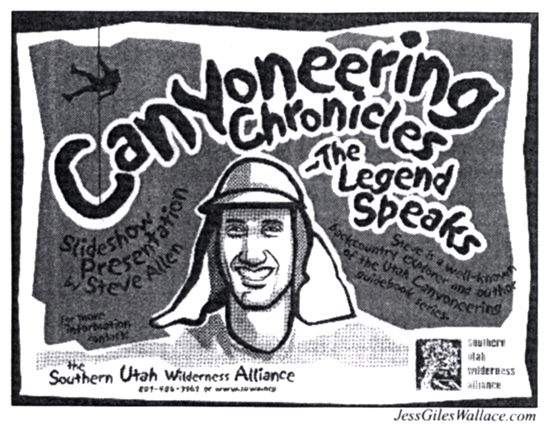
Imagine. Now SUWA was turning to its old adversaries at the BLM to limit and reduce the impacts from proposed increased backcountry use that SUWA wanted, in order to protect the very thing they hoped to save!
* Or consider New Mexican Jim Baca. He was Clinton’s Director of the Bureau of Land Management. Today he sits on the board of directors of SUWA. In 2006 he ran for public office, as New Mexico’s Land Commissioner. According to the Santa fe New Mexican, “Most of Baca’s big contributors are environmentalists. He received $15,000 from David Bonderman, a Texas venture capitalist who has served with Baca on the board of the national Wilderness Society and the Wyss Foundation, which pays for land conservation…and $10,000 from Hansjorg Wyss, the Pennsylvania manufacturer who started the Wyss Foundation.
Wyss, of course, is SUWA’s board chairman. If Baca were to have a serious policy disagreement with Wyss, even if it was of critical importance to the direction SUWA might take in the coming years, would Wyss’s contribution affect Baca’s willingness to openly disagree?
* The Nature Conservancy (TNC) lives with conflict and contradictions daily. For example, on its web site, TNC promotes what it calls, “The International Leadership Council (ILC).” The ILC, the web site explains, ” is one of the world’s leading corporate forums focusing on the challenges confronting biodiversity preservation, habitat conservation and natural resource management.”
One of The Nature Conservancy’s crowning achievements in Southeast Utah is the Scott Matheson Preserve, just north of Moab and adjacent to the Colorado River. The great wetlands area was in jeopardy years ago and TNC stepped in to buy the preserve. They have maintained that part of the Moab Valley ever since.
Among the donors to TNC’s Utah Living Lands & Waters Campaign, in 2006/2007, was a generous contribution ($100,000-$500,000) from Leucadia National Corporation, a longstanding member of The International Leadership Council. It has donated substantial sums, in the millions, to TNC over the years.
But Leucadia is also the developer and promoter of Cloudrock, just across the valley from the Scott Matheson Preserve. Working jointly with the Utah School and Institutional Trust Lands Administration (SITLA), Cloudrock is a massive upscale development that has already been approved by the Grand County Planning Commission and the County Council. Cloudrock proposes a 225-room lodge, 150 condominiums and 110 home sites on 1,935 acres of state trust lands on Johnsons Up On Top, a mesa on the east edge of the Moab valley.
But now, some environmentalists believe that the development could permanently damage the Moab Valley’s water supply. “Should damage occur to the aquifer,” they argue, “it is reasonable for the affected parties to insist that SITLA be responsible for the full cost of mitigation.”
Though Cloudrock has been in the works since 2000, no environmental group except Living Rivers has openly opposed the project.
* The Nature Conservancy has also accepted contributions from EnergySolutions, which has become a part of TNC’s “corporate alliance for the environment.” The Salt Lake City based company deals, “in nuclear services, including high consequence nuclear operations, such as high level waste management, spent fuel handling and transportation; complex D&D projects of nuclear reactors and highly radioactive nuclear facilities; high-end technical challenges such as fuel sludge treatment and high level waste treatment; and major decommissioning of both government and commercial nuclear facilities.”
Its President and CEO, Steve Creamer, is a familiar face in Utah. Creamer’s old engineering firm, Creamer & Noble, engineered the Quail Creek earthen dam near St. George, Utah, which burst in January 1989. The disaster caused $11 million in damages.
At the same time, Creamer became a household name in Moab. Again Creamer & Noble was involved with a proposed 83-mile highway through the Book Cliffs from the town of Ouray in Uintah County to Interstate 70 near Cisco in Grand County.
According to The Salt Lake Tribune, “Creamer & Noble was instrumental in getting the Legislature to give counties mineral royalties collected by the federal government, which Grand County planned to draw on when they paid the firm for its road engineering. The Grand County Council eventually killed the highway proposal, but not before the fight helped destroy the very structure of the county’s government.”
Now Steve Creamer and EnergySolutions have gained respectability, via some well-placed contributions.
 * John Hendricks is the founder and CEO of The Discovery Channel. A decade ago, he started buying up land near Gateway, Colorado, in order he said, “to save it.” Gateway was a small, buccolic rural widespot in the road and its residents were, for the most part, blissfully poor. Hendricks changed all that.
* John Hendricks is the founder and CEO of The Discovery Channel. A decade ago, he started buying up land near Gateway, Colorado, in order he said, “to save it.” Gateway was a small, buccolic rural widespot in the road and its residents were, for the most part, blissfully poor. Hendricks changed all that.
Hendricks built a 27,000 square foot home for himself, then turned his attention to a commercial enterprise on a scale larger than anything anyone might have imagined possible.
His Gateway Canyons Resort includes motels, restaurants, retails stores and one of the largest vintage automobile museums in the world. Coming soon…a golf course, convention center, a luxury vacation lodge and something called the Palisade Academy. The Grand Junction Sentinel says it’s a “getaway for intellectuals.” Hendricks calls it “a vacation for your mind.”
But this is how it works. Hendicks’ resort is expected to draw thousands of visitors. Now the BLM wants to develop a management plan for the 200,000 adjacent acres of public land.
According to the Sentinel story, “BLM spokeswoman Mel Lloyd said the resort will ‘benefit from being surrounded by public lands so their guests can go play there.’”
Here was public land, relatively untouched by anyone. Now the BLM thinks it needs to accommodate the thousands of tourists who will come to this remote part of Colorado for the first time.
But opposition to Hendricks’ Gateway dynasty by environmentalists in western Colorado was and continues to be negligible. He managed to buy off his opponents with charitable contributions to scores of non-profit organizations across the Western Slope, including land conservation easements with a value of $2,275,000 to The Nature Conservancy of Colorado.
* And this month, SUWA board member Chip Ward wrote a scathing attack on the resurgence of uranium mining in the West. In “Big Bad Boom: Radioactive deja vu in the American West,” for CommonDreams.org, Ward rightly deplores proposals for new nuclear power plants, but fails to mention SUWA’s connections to David Bonderman and his nuclear ambitions; nor does he encourage his friends at the Grand Canyon Trust to expell Bonderman from their board. Or return the hundreds of thousands of dollars in donations.
Ward rants about “flim-flam capitalism” and the tragic toll of life that the last uranium boom brought to so many, who he calls, “guinea pigs in an uncontrolled experiment.”
But again, as Wendell Berry said, “Conservation has a clear conscience.” .
THE BOTTOM LINE: “IT’S THE AMENITIES, STUPID!” (BUT WHAT ABOUT ‘GLOBAL WARMING?’)
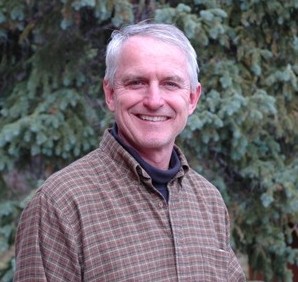 Almost a decade ago, Bill Hedden, then head of the Grand Canyon Trust’s Arches/Canyonlands office, now its executive director, wrote an essay for the Trust’s Advocate magazine. His observations about the ever-growing recreation ‘amenities economy’ could not have been more compelling or insightful.
Almost a decade ago, Bill Hedden, then head of the Grand Canyon Trust’s Arches/Canyonlands office, now its executive director, wrote an essay for the Trust’s Advocate magazine. His observations about the ever-growing recreation ‘amenities economy’ could not have been more compelling or insightful.
In part he said:
“Throughout the region…visitation has grown by more than 400 percent since 1980. This surge of interest has coincided with a proliferation of new recreation technologies–some exotic like modern ATVs, humvees, mountain bikes, climbing gear, jet skis and hangliders; and others prosaic like water filters, sunscreen and dry suits. Armed with these new toys, today’s legions of visitors can exploit every niche in familiar areas and enter terrain that previously was protected by remoteness…And though it is common to blame the destruction on a small percentage of lawless visitors, my experience brings to mind the old joke that a mere 99 percent of users give a bad name to all the rest. Make no mistake–we are in this together.
“The Grand Canyon Trust has just completed a major strategic planning exercise….Everywhere we looked, natural resource professionals agreed that industrial-strength recreation holds more potential to disrupt natural processes on a broad scale than just about anything else. It’s a very tough problem affecting all of us. We will be actively searching for ways to deal with it.”
But that was in 1999. The phrase, “amenities economy” was just becoming familiar to environmentalists. They were searching for a response to rural Westerners’ claim that wilderness designation and other restrictions on the West’s public lands were destroying its economy—an economy based in the traditional extractive industries like mining, ranching and timber.
Some within the conservation movement latched onto recreation and tourism—and the amenities that they demanded, as a “clean” economic solution. But Hedden’s concerns, in 2008, are almost antiquated notions, even to his own organization. In fact, even as Hedden was penning his 1999 concerns about “industrial strength tourism, the Grand Canyon Trust was embracing a massive development near the Grand Canyon called Canyon Forest Village. Tom DePaolo, a Scottdale, Arizona developer was the brains behind what he called, “an environmentally sustainable project.” It would have included 3,650 hotel rooms, 2,695 housing units, and, to appease the environmentalists, a natural history center. According to High Country News, “the environmental group Grand Canyon Trust and former Interior Secretary and Arizona native Stewart Udall call De Paolo’s plan a visionary solution. Ultimately Canyon Forest Village failed because motel owners and other tourist-based businesses in Flagstaff and Tusayan feared the project would hurt their revenues. Curiously, on GCT’s website “timeline,” it fails to mention thir support for DePaolo’s project, but it does note that it was defeated, as if they opposed it all along.
GCT’s Advocate, in the next decade, published one story, in 2006, about the amenities threat. In a poignant essay by Laura Kamala, about the transformation of Moab, it was more a lament than a call to action.
At the same time, GCT supported the Hualapai Indian reservation’s $30 million plexiglass “Skywalk,” a Disneyfied tourist attraction west of Grand Canyon Village that former Grand Canyon National Park superintendent Robert Arnberger called,”the equivalent of an upscale carnival ride…Why would they desecrate this place with this?”
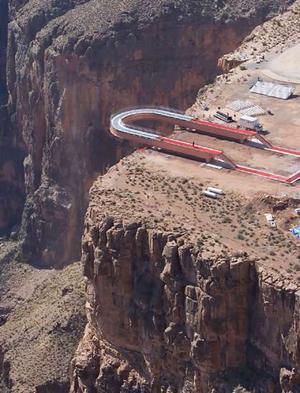
According to the LA Times, “‘Skywalk is the ‘wow’ that will draw people,’” said Steve Beattie, the chief financial officer for Grand Canyon Resort Corp., the tribe’s business arm. Construction on an attached 6,000-square-foot visitors center and restaurant is to begin after the walkway opens. The Skywalk will charge an admission fee of $25, Beattie said, adding that some of the financing will come from a private-sector partner.”
The LA Times continued, “…this isn’t just about the Skywalk, a steel-and-glass viewing platform that will be cantilevered 70 feet out over the canyon at a cost of more than $30 million. It’s about zooming in a helicopter below the canyon rim… In this alternative canyon, the helicopters can dip deeply because they’ve been excused from federal restrictions that keep other canyon flights higher up.”
And the Arizona Republic chides, “It’s shameless, of course. But you’ve got to admire their chutzpah.”
The reservation insists it has no choice but to embrace this kind of tourism to deal with the social ills of its people. But at what cost to its soul?
Indian Country.com included these observations by a 70 year old tribal elder, Dolores Honga: ‘’We have disturbed the ground,’’ She said workers on the Skywalk site often complain to her about nightmares.
‘’Our people, they died right along the land there. Their blood, their bones were shattered. They blend into the ground. It’s spiritual ground. This is why you’re awakened.”
But the Associated Press reported, “The Grand Canyon Trust, one of the chief protectors of the canyon, has not raised any environmental or aesthetic objections to the Skywalk.”
Google your favorite green group and mix it with “oil and gas” or “ATV” or “seismic exploration,” or “coal-fired power plant” and you will find hits by the thousands. Try the same process with “amenities economy” or “mountain bike impacts” or “canyoneering.” or “rock climbing” or “non-motorized recreation impacts.” Hits are scarce, and if Google does connect, the link is usually something like this:
“Just received my annual reminder to donate today to SUWA, the Southern Utah Wilderness Alliance. For all you desert climbers near Moab, be sure to do your part and toss some bucks their way soon.” It was from www.yourclimbing.com.
Another phrase joining the lexicon at about the same time was “global warming.” The public was finally considering the warnings of scientists world-wide. Had the human race and its insatiable consumption of our planet’s natural resources put its very survival in jeopardy? It appeared that we were finally ready to listen.
The Amenities Economy…Global Warming.
The two expressions would seem to be at odds with each other, since the amenities economy requires the consumption of massive amounts of our dwindling natural resources, including untold millions of barrels of oil, to be successful.
But remember again, Wendell Berry’s admonition: To the conservation movement, it is only production that causes environmental degradation; the consumption that supports the production is rarely acknowledged to be at fault.”
At the end of the day, it comes down to this…
The combination of an environmental movement in the 21st Century, funded by some of the wealthiest entrepreneurs in America, and pushing for a New West amenities economy that boasts a stunning demand for natural resources, all the while self-righteously opposing and fighting the search for and production of the very natural resources the amenities economy demands, is hypocrisy on a level never dreamed possible, even by some of the current leaders of this movement, just a decade ago.
Consumption? Good. Production? Evil.
Wendell Berry also said: “To the extent that we consume, in our present circumstances, we are guilty. To the extent that we guilty consumers are conservationists, we are absurd.”
And yet the absurdity continues. And grows.
From coast to coast, some of the most powerful environmental groups in America look to a growing economy and more material prosperity to combat global warming. “On Earth,” the magazine of the NRDC, the same organization that reversed itself on nuclear power, thanks in part, to the power of David Bonderman, declares with unbridled enthusiasm, “We can stave off the biggest environmental and humanitarian crisis without disrupting economic growth…Business executives…are beginning to see significant economic opportunities in tackling global warming.”
And it adds, “The health of our planet and the health of our economy don’t have to be at odds. …Historically, industry executives have reluctantly confronted environmentalists in courtrooms. But today (Rick) Duke, who heads up NRDC’s newly launched Center for Market Innovation, meets with them in their corporate offices to discuss the financial upside to addressing global warming…”
Or consider these observations from NEWSWEEK, from a story titled, “How to Make a Buck Green:”
“So where’s the money in climate change? Investors sense a tumultuous market in the making, if they can only hit it right. ‘Sometimes I feel like a fly on the wall, watching a new era unfold,’ says Rona Fried, editor and publisher of ‘Progressive Investor,’ a six year old newsletter that follows the field…Wall Street’s own change in climate is nothing less than astonishing. Save-the-planet investing has suddenly, well, heated up.”
Indeed. Just a week earlier, the same periodical featured the “Green Giant” on its cover, California’s Governor Arnold Schwarzenegger. NEWSWEEK proclaimed, “California’s Hummer-loving governor is turning the Golden State into the greenest in the land, a place where environmentalism and hedonism can coexist.”
And when you descend to the “grass roots,” the story is the same. SUWA’s executive director told High Country News, just two years ago, “The environmental movement has not advocated for this new economy… But the new economy is being driven by forces that are far greater than we are.”
Yet what economy is more driven by forces greater than environmental groups than the world-wide quest for oil? SUWA is there to fight. Again, oil is production. Burning it is consumption.
And in 2007, SUWA finally embraced openly the very economy it has tried to distance itself from.
 In a KCPW public radio story from 2007, “The Outdoor Industry Foundation says outdoor recreation has an annual economic impact of $6 billion a year in Utah and accounts for 65,000 jobs. That’s making state officials more receptive to conserving wilderness, says Scott Groene of the Southern Utah Wilderness Alliance.”
In a KCPW public radio story from 2007, “The Outdoor Industry Foundation says outdoor recreation has an annual economic impact of $6 billion a year in Utah and accounts for 65,000 jobs. That’s making state officials more receptive to conserving wilderness, says Scott Groene of the Southern Utah Wilderness Alliance.”
Groene explained, “When the Outdoor Industry a couple years ago spoke up about the importance of their industry and threatened to pull the [Outdoor Retailer] tradeshow from Salt Lake City, they got the governor’’s attention. And it changed the debate from one that protecting lands would devastate local economies to not only would they not devastate local economies but there was actually a benefit to protecting lands.”
According to the KCPW article, “Groene says being eco-friendly isn’t just for activists like SUWA. It’s also good business.”
At the Grand Canyon Trust, it had opposed a proposed Lake Powell to St. George water pipeline. Hedden wrote in 2002 that it, “illustrates the way proponents of these projects typically fail to visualize a future any of us might want to live in. … A pipeline has potential to spread sprawl from the city all the way to Big Water near Lake Powell. We will be working to make sure no pipeline is built that threatens the integrity of that wild landscape.”
But in 2004, GCT withdrew its opposition to the pipeline, because, according to its water issues director Nikolai Ramsey, “It has been our experience that growth is rarely, if ever, stopped by shutting off the water supply. If the people are coming, the water will be brought in, with politicians cheering all the way. This is obviously true in St. George.”
St. George is expected to grow to half a million residents by mid-century. Just a hundred miles west on Interstate 15, Bonderman’s vast Las Vegas interests grow more prosperous and a booming St. George can only be good news for Vegas.
In fact, Bonderman sees a bright future in the travel/amenities industry; his connection to G2 Switchworks is a good example.
From its web site, “G2 is singularly focused on developing highly automated, customer centric travel reservation and management solutions that allow travel suppliers and travel sellers to more effectively serve their customers.”
Bonderman and TPG signed on in 2005. His enthusiasm was unmistakable: “The travel industry faces a wide variety of obstacles due to archaic technologies and outdated business processes. The market demands a more efficient, feature rich alternative to the current offerings of existing global distribution systems…The combination of G2’s early success, revolutionary technology and proven expertise places the company in an excellent position to take significant market share from these legacy providers.”
Not exactly Wendell Berry.
Meanwhile, many of its other board members, with vested interests in tourism and recreation and the amenities economy can only cheer the exponential growth of an industry that its own executive director once warned held “more potential to disrupt natural processes on a broad scale than just about anything else.”
‘CALIFORNICATION’… 35 YEARS LATER
In 1972, TIME magazine introduced a new word to its national readership: Californication. Correspondent Sandra Burton toured the Rural West for two weeks and filed a remarkable report. She noted:
“In a starkly beautiful New Mexico setting, a billboard catches the eye: UNDEVELOP! Undevelop?…Minutes later, however, the message of the half-whimsical New Mexico Undevelopment Commission begins to make sense as the car whizzes past a transformer station. Utility poles grow stouter and taller, then pick up extra arms to hold more wires. The highway takes on another lane. Exit ramps and gas-station signs run closer together. The road cuts through the backyards of a hundred tract homes, passes the parking lots of the satellite shopping centers and suddenly rises above the city——affording a view of Albuquerque’s ugly urban sprawl. The city’s future and that of much of the rest of the once-wild West is written large upon a developer’s billboard dead ahead: TOMORROW FOR SALE, 36 MILES.”

Environmentalists and old time locals alike saw the threat of an urbanized rural West, even then. TIME reported that, “Conservation groups fantasy building one-way overpasses straight through to Canada to keep Californians out of Oregon, or constructing an adobe wall around New Mexico to keep the Texans from straying in, and worse, staying.”
In Colorado, citizens and even politicians were organizing to take action. Some were even hopeful. Then US Congressman Richard Lamm declared, “We are beginning to overcome a whole heritage of mindless Chamber of Commerce promotionalism.”
A movement began to stop the Olympics from coming to Colorado. And a couple years after the TIME story was filed, Colorado citizens, by referendum, said NO. It was unprecedented.
But the TIME reporter could not help but be influenced by a popular expression of the time, inspired by the environmental conscience of America’s comic strip page. Walt Kelly’s “Pogo” had warned us all… “WE have met the enemy…and they is US.”
TIME’s story concluded: “While the experts ponder, the current dilemma remains and can be read on the backs of the ever-multiplying automobiles that choke Western city streets. The license plates still brag about BIG SKY COUNTRY and LAND OF ENCHANTMENT, but the bumper stickers inches away now plead SAVE THIS ENVIRONMENT——KEEP OUT or DON’T CALIFORNICATE COLORADO. The odds are good, of course, that the stickers were applied by people who recently immigrated themselves.
“As Brant Calkin, a Santa Fe Sierra Club official observes: ‘Everybody wants to be the last son of a bitch to move in.’”
In 2008, being a son of a bitch just isn’t what it used to be. But when you’re a rich SOB, who’s going to complain?
NOTE: For more information, here are the web links that I used to write “Greening of Wilderne$$…part 2.” If the especially long URLs don’t work, cut it back to the core of the address and search on-site for the story….JS
http://www.lasvegascitylife.com/articles/2007/01/11/news/local_news/iq_11877845.txt http://www.vegaspopular.com/2007/02/07/wanna-buy-a-rock-star-how-big-celebs-demand-big-paydays-andre-agassi-wants-you/ http://www.g2switchworks.com/g2pr.php?i=PAX3MNBIWG http://www.azcentral.com/arizonarepublic/opinions/articles/1002sun2-02.html http://indiancountry.com/content.cfm?id=1096414304 http://www.forbes.com/lists/2006/99/EGH8.html http://www.sec.gov/news/press/2007/2007-195.htm http://www.loe.org/shows/segments.htm?programID=07-P13-00015&segmentID=1 http://www.onearth.org/article/wall-street-calls http://www.mesacounty.us/mcweb/longrangeplan/Master%20Plan/Gateway%20Plan.pdf. http://komodo.nocdirect.com/pipermail/nukenet_energyjustice.net/2007-April/001981.html http://www.gjsentinel.com/search/content/news/misc/stories/2008/01/24/gateway_main.html http://groups.google.com/group/misc.invest.stocks/browse_thread/thread/ea5070bc29ce2f4b/d112d64783c6617e http://blogsofbainbridge.typepad.com/ecotalkblog/nuclear_power/index.html http://www.youtube.com/watch?v=VjJLV_frjg8&feature=user http://www.dealbreaker.com/private_equity/texas_pacific_group/ http://www.hcn.org/servlets/hcn.Article?article_id=3990 http://www.pbs.org/newshour/bb/environment/July-dec99/grandcanyon_8-9.html http://forests.org/archived_site/archive/america/coraloky.htm http://www.grandcanyontrust.org/about/timeline.php http://www.sportsbusinessdaily.com/article/112562 http://en.wikipedia.org/wiki/Harrah%27s_Entertainment http://www.lowcarbonlife.net http://smdp.com/site/archives/033007.pdf http://mccombsetg.blogspot.com/2007/04/txu-sheds-coal-plan-charts-nuclear-pat.html http://www.emediawire.com/prfiles/2007/01/25/500303/co2chartcopy.jpg http://www.ciarancuffe.com/PR/2007/PR070105E.Cuffe.Blasts.Foolish.O’Leary.htm http://news.bbc.co.uk/1/hi/uk_politics/6233019.stm http://www.dailymail.co.uk/news/article-426626/Fear-new-jet-tax-minister-savages-anti-green-airlines.html http://www.nytimes.com/2007/02/26/business/26coal.html?pagewanted=1 http://www.theinvestor.ie/BigDeal/bigdealapril07.html http://www.treehugger.com/files/2007/02/in_texas_good_g_1.php http://www.kcpw.org/article/4084 http://www.hcn.org/servlets/hcn.Article?article_id=1258 http://deseretnews.com/article/1,5143,695221627,00.html http://www.equilar.com/NewsArticles/051307_palmbeachpost.pdf. http://money.cnn.com/magazines/fortune/fortune_archive/2005/04/04/8255948/index.htm http://www.time.com/time/magazine/article/0,9171,877985-1,00.html http://www.commondreams.org/archive/2008/06/19/9748/ http://www.telegraph.co.uk/money/main.jhtml?xml=/money/2005/02/25/cnryanair25.xml http://travel.latimes.com/articles/la-tr-skywalk11mar11 http://www.usatoday.com/travel/flights/2007-04-02-midwest-skywest-regional-jets_N.htm http://www.tradingmarkets.com/.site/news/Stock%20News/1062670/?hcode=relatednews http://www.youtube.com/watch?v=slp1eKp1zfY&feature=related http://www.boston.com/news/globe/ideas/articles/2007/03/18/climate_shift/ http://www.freenewmexican.com/news/50065.html http://www.nature.org/wherewework/northamerica/states/utah/files/fall_2007.pdf http://www.nature.org/joinanddonate/corporatepartnerships/leadership/members.html http://www.moabtimes.com/pages/full_story?article-New-appeals-contest-PC-approval-of-Cloudrock-special-exceptions%20=&page_label=full_story&id=70711&widget=push&open=& http://www.consumeraffairs.com/news04/2006/12/grand_canyon_skywalk.html
















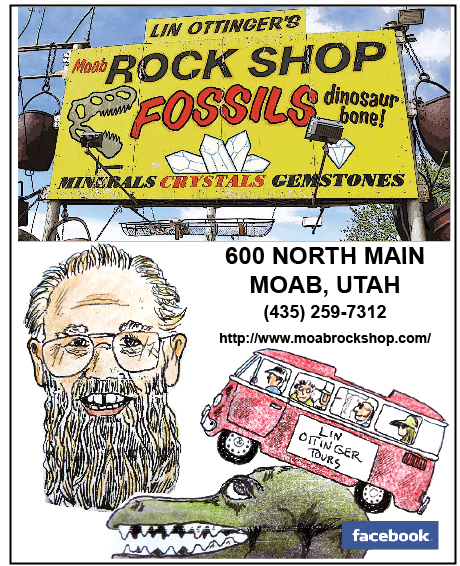

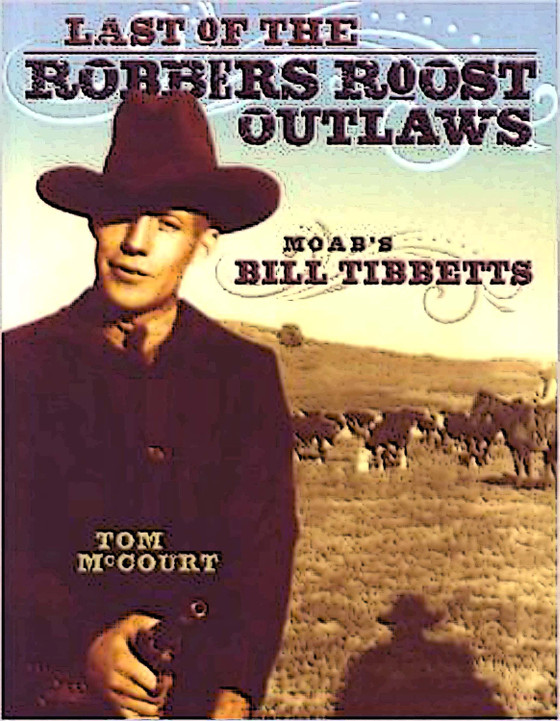
0 Responses
Stay in touch with the conversation, subscribe to the RSS feed for comments on this post.